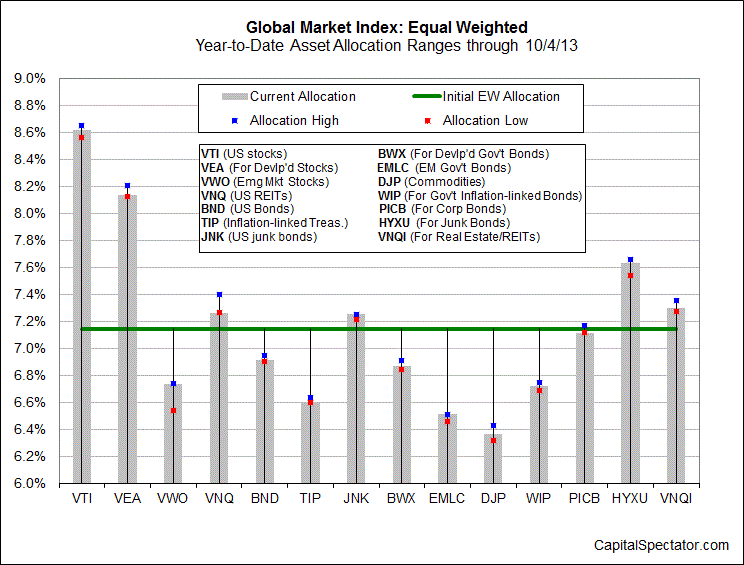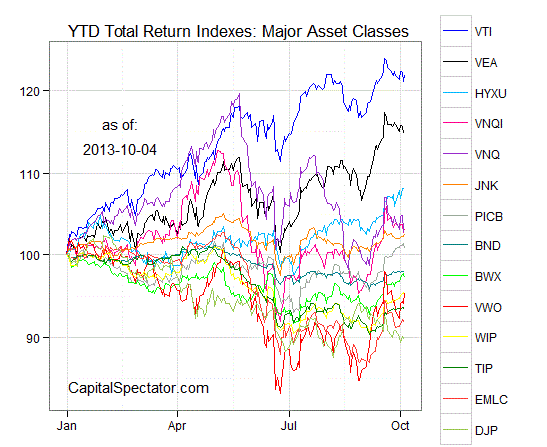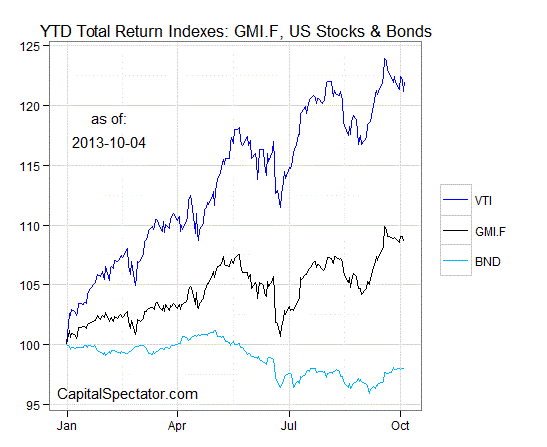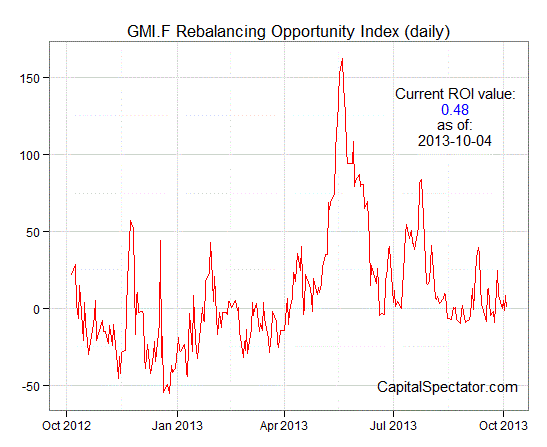The federal government’s partial shutdown is no closer to resolution, but so far the markets are shrugging off Washington’s fiscal stalemate. It remains to be seen if the indifference will endure if the deadlock in Congress continues and the threat of a self-inflicted default draws closer. "On [October] 17th, we run out of our ability to borrow, and Congress is playing with fire," says Treasury Secretary Jacob Lew. "If they don’t extend the debt limit, we have a very, very short window of time before those scenarios start to be played out."
If all this poses a risk, and it does, Mr. Market is showing minimal signs of distress at the moment. Notably, US stocks are still trading near their highs for the year. Our proxy ETF for domestic equities (Vanguard Total Stock Market (VTI)) is up a hefty 22% year to date through October 4. The big loser among the major asset classes is a broad basket of commodities, based on the iPath DJ-UBS Commodity Index (DJP), which is lower this year by almost 10% as of Friday’s close.
For another perspective, consider the relative changes in the asset allocation of an equal-weighted portfolio of the major asset classes this year. The chart below depicts the current portfolio composition (based on proxy ETFs) in context with the range of allocations year to date, based on a start date of Dec. 31, 2012 for the equal weights. The strategy for this illustration is equally weighting everything and letting the unmanaged allocations fluctuate freely through October 4. 
Turning to a review of how the individual markets have performed, the next chart shows the year-to-date results in relative terms through October 4 with all the ETF prices rebased to 100 as of Dec. 31, 2012:
Next, here’s how an ETF-based version of a passive, market-value-weighted mix of all the major asset classes stacks up so far in 2013—the Global Market Index Fund, or GMI.F. This investable strategy benchmark is higher by 8.9%, or roughly midway between the year-to-date returns for US stocks and bonds.
In addition, consider how the Rebalancing Opportunity Index (ROI) for GMI.F has evolved. This benchmark, which uses the dispersion of returns as a measure of the fluctuating potential for enhancing return, lowering risk, or both via rebalancing, is currently close to neutral in its near-zero reading. In other words, the potential for adding value with rebalancing looks relatively low compared with the 150-plus levels in May 2013. (Note: ROI's calculation in the chart below is based on rolling 1-year returns for each of the 14 ETF components in GMI.F--the "standard" view on these pages. Adjusting the historical window to reflect alternative time horizons and/or the asset mix will dispense different ROI values. For a brief overview of ROI, see this post.)
- English (UK)
- English (India)
- English (Canada)
- English (Australia)
- English (South Africa)
- English (Philippines)
- English (Nigeria)
- Deutsch
- Español (España)
- Español (México)
- Français
- Italiano
- Nederlands
- Português (Portugal)
- Polski
- Português (Brasil)
- Русский
- Türkçe
- العربية
- Ελληνικά
- Svenska
- Suomi
- עברית
- 日本語
- 한국어
- 简体中文
- 繁體中文
- Bahasa Indonesia
- Bahasa Melayu
- ไทย
- Tiếng Việt
- हिंदी
Asset Allocation Review: U.S. Stocks Still Trading At Highs
Published 10/07/2013, 07:01 AM
Updated 07/09/2023, 06:31 AM
Asset Allocation Review: U.S. Stocks Still Trading At Highs
Latest comments
Loading next article…
Install Our App
Risk Disclosure: Trading in financial instruments and/or cryptocurrencies involves high risks including the risk of losing some, or all, of your investment amount, and may not be suitable for all investors. Prices of cryptocurrencies are extremely volatile and may be affected by external factors such as financial, regulatory or political events. Trading on margin increases the financial risks.
Before deciding to trade in financial instrument or cryptocurrencies you should be fully informed of the risks and costs associated with trading the financial markets, carefully consider your investment objectives, level of experience, and risk appetite, and seek professional advice where needed.
Fusion Media would like to remind you that the data contained in this website is not necessarily real-time nor accurate. The data and prices on the website are not necessarily provided by any market or exchange, but may be provided by market makers, and so prices may not be accurate and may differ from the actual price at any given market, meaning prices are indicative and not appropriate for trading purposes. Fusion Media and any provider of the data contained in this website will not accept liability for any loss or damage as a result of your trading, or your reliance on the information contained within this website.
It is prohibited to use, store, reproduce, display, modify, transmit or distribute the data contained in this website without the explicit prior written permission of Fusion Media and/or the data provider. All intellectual property rights are reserved by the providers and/or the exchange providing the data contained in this website.
Fusion Media may be compensated by the advertisers that appear on the website, based on your interaction with the advertisements or advertisers.
Before deciding to trade in financial instrument or cryptocurrencies you should be fully informed of the risks and costs associated with trading the financial markets, carefully consider your investment objectives, level of experience, and risk appetite, and seek professional advice where needed.
Fusion Media would like to remind you that the data contained in this website is not necessarily real-time nor accurate. The data and prices on the website are not necessarily provided by any market or exchange, but may be provided by market makers, and so prices may not be accurate and may differ from the actual price at any given market, meaning prices are indicative and not appropriate for trading purposes. Fusion Media and any provider of the data contained in this website will not accept liability for any loss or damage as a result of your trading, or your reliance on the information contained within this website.
It is prohibited to use, store, reproduce, display, modify, transmit or distribute the data contained in this website without the explicit prior written permission of Fusion Media and/or the data provider. All intellectual property rights are reserved by the providers and/or the exchange providing the data contained in this website.
Fusion Media may be compensated by the advertisers that appear on the website, based on your interaction with the advertisements or advertisers.
© 2007-2025 - Fusion Media Limited. All Rights Reserved.
